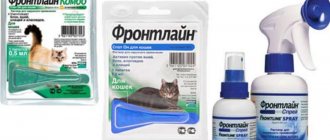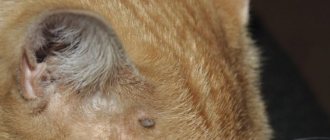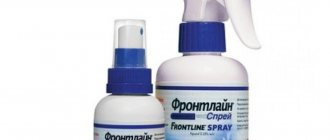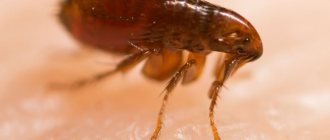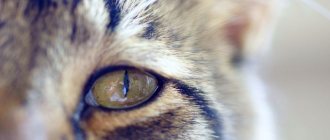Blood-sucking ectoparasites not only cause itchy skin that bothers pets, but also carry serious diseases. Both free-roaming pets and those that have never been outside can become infected with them. A lot of products have been developed to combat fleas, among which the imported Front Line line stands out.
Let's learn how to use different forms of this drug for cats.
Skin parasites of cats
The most common and common in cats are:
- Fleas choose not only animals as victims, but also humans. Insects actively jump on the animal's skin and are easy to notice. More than 60 species of blood-sucking parasites carry over 200 diseases: anthrax, typhoid fever, salmonellosis, helminthiasis, and various fungal infections. Adult fleas do not live on the victim's body 24 hours a day. Having had enough, they leave the cat.
- Lice eaters are small wingless insects. They feed on particles of fur and epidermis, and blood. Like other ectoparasites, lice eaters force the cat to constantly scratch the skin until wounds appear. Damaged skin is easily attacked by pathogenic bacteria. When a cat is infected with a lice-eater, sleep and appetite are disrupted, immunity decreases, and allergies occur.
- Lice - when infested with lice, the animal behaves restlessly, scratches the skin, and loses hair. Lice are easy to spot. On your pet's light coat, black dots that look like dirt and dust are clearly visible - these are parasite excrement. In case of mass infection, the animal faces dermatitis and complete baldness. Lice are carried by helminth larvae.
- Ixodid ticks - attack cats in the warm season. These small insects feed on blood and grow greatly in size. A swollen tick can be noticed immediately. A cat's skin and fur are very sensitive, so the animal can easily shake off an unattached tick from its skin. In search of food, insects willingly move onto people. Ticks carry many diseases: viral encephalitis, typhus, tularemia, hemorrhagic fever, piroplasmosis, helminthiasis, etc.
- Scabies mites live on the skin of a cat, gnawing passages in the inner layer of the dermis. They feed on epithelial cells and lymph. From a sick animal the tick is transmitted to people.
- Sarcoptoid mites are the cause of scabies. The peculiarity of this form is the rapid baldness of the ears, belly and muzzle.
- Ear mites - attack the animal's hearing system. The cat shakes its head and tries to get its hind paw inside the ear. Dark brown crusts form in the ears, followed by pus. Without treatment, the parasites gradually penetrate through the inner ear into the brain, and the animal dies.
- Heartworms (dirofilaria) cause one of the most dangerous diseases, dirofilariasis. The helminth larvae enter the mouthparts of the mosquito with the blood of the infected creature, and with the next bite the parasites enter the body of the final victim. They live under the skin, in the muscles of internal organs. Parasites destroy the heart, lungs, and coronary vessels. Without treatment, the animal faces death.
Photo gallery: dangerous cat ectoparasites
Fleas are the most common skin parasites
Hairworm - the cause of focal baldness in cats
Cat lice are as common as fleas, although they are less well known.
Hungry and well-fed ticks are very different in appearance
Getting rid of ear mites is a long and expensive task.
Heartworm is the causative agent of dirofilariasis, spread by mosquitoes.
Recommendations
There is no need to bathe the animal 2 days before and 2 days after treatment. Until the fur is completely dry, you need to make sure that the animal does not lick the drug. Also, do not allow it near heating devices or open fire. Young children should be excluded from contact with the animal for 24 hours. During this time you cannot pet him. To avoid re-infestation and prevent fleas from breeding, the bedding should be replaced. In addition, the following rules must be observed:
- after applying the spray, you should wash your hands with soap;
- when applying the product, do not eat, drink or smoke;
- the drug should be stored out of the reach of children.
High effectiveness of the drug is achieved by following the recommended regimen of its use. When using the product, you should not use other insectoacaricidal drugs.
Composition and release form of the drug Frontline
To combat skin parasites of cats, the French corporation Merial SAS created the drug Frontline. The company conducts serious research and has a strong reputation in the market for manufacturers of veterinary drugs.
The drug is available in three dosage forms:
- drops in polyethylene pipette bottles with a volume of 0.5 to 4.02 ml;
- spray in bottles with a sprayer of 100, 250 and 500 ml;
- Chewable tablets (for dogs only)
Table: dosage forms for cats
| Name | Dosage form | Volume, ml | Included | |
| active substance | Excipients | |||
| Frontline Spot On | drops on the withers |
| fipronil |
|
| Frontline Combo | drops on the withers |
|
|
|
| Frontline Spray | spray |
| fipronil |
|
Photo gallery: release forms
Frontline spray with a volume of 100 and 250 ml is most convenient for home use
Drops for the withers Frontline Spot It are available in a dropper bottle with detailed instructions
Frontline combo acts not only on adult parasites, but also on their eggs and larvae
Frontline Nexgard meat-flavored chewable tablets are for use only in dogs.
Active ingredients of the veterinary drug Frontline:
- Fipronil has a detrimental effect on the central nervous system of parasites, disrupting the movement of nerve impulses. Causes paralysis and subsequent death of insects. Fipronil does not have a systemic effect on the body of a pet, destroying only pests.
- S-methoprene (as part of Frontline Combo) is an analogue of the hormone-regulator of insect growth, causes developmental anomalies at the egg and larval stages, prevents the appearance of adult individuals on animals and in places where they are kept.
Additionally, Frontline contains excipients:
- in the spray - isopropanol, copolyvidone, purified water, polysorbate;
- in drops on the withers - butylated hydroxyanisole, butylhydrotoluene, diethylene glycol, polyvidone, polysorbate.
The content of the active substance in any form ensures effective destruction of parasites.
Instructions for use and precautions
Treatment is carried out outdoors and indoors with open windows or a ventilation system that provides a good flow of fresh air. It differs for different release forms.
Drops are applied to the animal’s withers, after spreading the fur. You need to try to get the liquid directly onto the skin. Sprays are sprayed against hair growth. Tablets are given orally.
When treating, a few drops are instilled directly into the animal's ear. After this, the ear is folded in half and lightly massaged for better penetration of the substance. When applying the composition, it is necessary to avoid getting it into the animal’s mouth or eyes. To do this, before using the spray, moisten the area around the eyes, nose and mouth with clean, cool water. If trouble cannot be avoided, you should rinse off the remaining substance with plenty of water to relieve your pet of the tingling sensation caused by the substances included in the composition.
After the product is applied, the animal is held until the fur dries. This will avoid the transfer of active substances to pieces of furniture. You should also isolate the animal from contact with children for a day. At this time, it is better to refrain from playing with your pet and stroking it.
The maximum effect is achieved one day after application. It is allowed to wash your pet no earlier than 48 hours after the end of the procedure.
If there are several animals in one apartment, it is better to carry out preventive procedures for all on the same day. For prophylaxis, Frontline is used every 4 weeks. If the animal is bathed daily, it is recommended to reduce the time interval between treatments.
If the drug comes into contact with exposed skin of the person carrying out the treatment, the stained area should be washed with plenty of running water. Empty Frontline bottles are strictly prohibited from being reused for storing any substances or for other household purposes. After use, the empty container is tightly closed with a lid, packed in a plastic bag and thrown into the trash.
Mechanism of action
After use, the active substance does not penetrate into the blood, but is distributed throughout the skin and hair. The drug has a contact effect - parasites die when they come into contact with Frontline microparticles. After the product gets on the skin, the active agents fipronil and S-methoprene, together with sebum, are distributed over the surface, enveloping the hairs and covering every millimeter of the cat’s body with an invisible veil.
Frontline acts contactally, destroying only parasites
Overview of the features of the Frontline action
Frontline refers to products used to eliminate and prevent the appearance of ectoparasites in cats and dogs. The drug has a superficial effect. After use, the components of the drug do not enter the blood, but are distributed over the surface and accumulate in the sebaceous glands. From these, the drug is gradually applied to the skin in the amount necessary to destroy parasites. Thus, after a single treatment, the effect of the drug remains for a fairly long period.
Fleas on a cat
Frontline destroys the following types of skin parasites:
- fleas;
- ixodid ticks;
- cheilitels;
- otodexodes;
- lice eaters;
- lice.
Life cycle of a dog flea
Frontline is produced in several forms, allowing you to choose the one that will be convenient to use for the animal owner.
Frontline composition
The main substance that provides the insecticidal effect of the drug is fipronil. In addition, in various forms of release, Frontline can be supplemented with several substances to enhance effectiveness. Among them:
- butylated hydroxyanisole;
- ethanol;
- butylated hydroxytoluene;
- excipient.
Chemical formula of finpronil
Pharmacology
Fipronil, which is the basis of the drug, affects insect receptors, disrupting the movement of impulses. This causes paralysis and subsequent death of the arthropods.
Frontline is active against almost all common skin parasites of animals. Accumulating in the hair follicles, epidermis and sebaceous glands, fipronil enters the animal’s skin along with the secretion. The effect occurs after 24-48 hours. During this time, the parasites present on the animal die, and the drug is completely absorbed into the skin. The protective properties last for a period of 15 to 45 days. The duration of exposure largely depends on the size of the animal, characteristics of care and accommodation.
The structure of a dog's skin
Contraindications and side effects
After the studies, no obvious side effects or contraindications to the use of the drug were identified. The manufacturer recommends refraining from treating kittens weighing up to 1 kg with the universal product to avoid overdose. If there is a need to process them, it is better to use Frontline, created for small animals. The concentration of the active substance in such preparations is significantly lower than in products for adults. They have a gentle effect on the still fragile body.
Treatment of a kitten with Frontline, created for small animals
It is also recommended to avoid using the product on animals with damaged skin. Multiple wounds can lead to penetration of the active substance into the blood. This will not cause any negative effects on your pet, but may cause minor short-term deterioration in well-being.
How to use Frontline correctly - treatment algorithm
Before treatment, it is recommended to weigh the cat, determine the required dose, comb the cat’s fur, and remove all tangles. The pet's skin must be completely dry, undamaged, without open wounds or visible scratches at the site of application. For cats, the drug Frontline is used in 0.5 ml applicators.
The procedure for treating a cat with drops on the withers at home:
- Wear protective gloves.
- Remove the dropper bottle from the packaging, move the drug into the wide part of the bottle using tapping movements, and unscrew the tip of the dropper.
- Spread the fur at the withers, exposing the skin at the junction of the cervical spine and the thoracic spine (on the shoulder blades).
- Squeeze the pipette and apply a few drops of the solution in a heap, in a checkerboard pattern.
- Distribute the preparation over the skin, running your hand several times against and along the growth of the fur.
Video: how to treat a cat for fleas using drops
Remember! Drops are applied pointwise in a checkerboard pattern to the area between the shoulder blades (at the withers).
To get rid of ear mites, 4-6 drops are injected into each ear canal. To distribute the drug evenly, the ear is closed and easily kneaded. The remaining drops in the pipette bottle can be applied to the withers.
Remember! For 2 days after treatment, protect the cat’s fur from moisture, do not bathe or use other drugs against skin parasites.
The procedure for self-treating a cat with Frontline spray:
- Processing should be done outdoors or in a well-ventilated area.
- Wear protective gloves and respiratory protection.
- Fasten the pet's protective neck collar and secure its jaws until the preparation dries completely on the fur.
- Fluff the cat's fur against the natural hair growth.
- Shake the bottle thoroughly.
- Holding the spray can upward at a distance of 10–20 cm from the cat, press the head of the aerosol can.
- Treat your pet until the fur is moistened, starting from the tail: back, belly, limbs.
- To treat the face, groin and armpits, apply the product to the glove and rub into the fur, avoiding contact with the eyes and mucous membranes.
- Brush the fur with a wide-toothed brush to get the product onto the skin.
The drug consumption is 3 ml per 1 kg of weight for short-haired cats and 6 ml for long-haired cats. The product is convenient to dose: one press removes a 0.5 ml dose of Frontline from a 100 ml bottle.
Typically required for cats weighing:
- up to 5 kg - from 30 for short-haired to 60 clicks for long-haired animals;
- up to 10 kg - from 60 to 120 presses;
- up to 15 kg - from 90 to 180 presses.
A single treatment of a cat with Frontline kills parasites in 1–2 days. Barrier protection against ticks lasts for 4 weeks, against fleas, lice and lice for 6 weeks.
Video: how to treat your pet for skin parasites using a spray
Remember! Treat all animals in the house, change bedding or disinfect them, otherwise re-infection is possible.
I recently got a new cat. A foundling, like all my animals. The poor guy jumped out onto the road opposite the dacha cooperative. It was at the end of autumn, with the onset of the first cold weather. The unfortunate animal was on the verge of death. I took him home. The cat was so scared and exhausted that I decided to give him time to recover from the stress. He went to the vet 3 days later. Upon examination, all possible parasites were discovered: worms, fleas and ear mites. The cat was prescribed treatment. The doctor advised to wait 5 days and treat for fleas and helminths. While the waiting period was passing, the other cat also began to itch, although the animals had almost no contact. During the second visit, the veterinarian recommended treating the cat with Frontline Combo anti-flea drops on the withers once, and treating the cat with Frontline Spot On drops twice according to the scheme. And he focused on replacing or disinfecting bed mats. I didn’t even think about changing the bedding! There was no need to wear any collars, and there was no aggressive smell; both pets tolerated the procedure well. An easy and simple solution, and the fleas were defeated. I noted for myself the importance of regular flea treatment. Parasite eggs can be brought in from the street on the soles of shoes. And then the infection will occur again.
Frontline spray
The aerosol product is produced in bottles of 100; 250 ml.
The cost of a 100 ml bottle in September 2021 is 845 rubles.
The spray protects cats from ixodid ticks for 3 weeks, fleas - 6 weeks. The dogs will be free of ectoparasites for 5 and 12 weeks respectively. Dispense the drug with the number of presses on the spray head in accordance with the table:
| Live weight, kg | Number of clicks | |
| 100 ml | 250 ml | |
| 5 | 30 | 10 |
| 10 | 60 | 20 |
| 15 | 90 | 30 |
| 25 | 150 | 50 |
The table provides recommendations for treating pets with short hair. For long-haired dogs, the number of presses is doubled. To prevent a cat or dog from licking the insecticide, place a neck collar, muzzle, or tie the closed jaws with a rope while it dries. Avoid contact of the aerosol with the eyes. Problem areas are treated with your finger after wearing gloves.
The animal should not be allowed to get wet for two days after treatment. There are no restrictions on the weight and age of the animal. The aerosol is stored for 2 years at temperatures from 0 to 25 °C.
Indications for use
Frontline is prescribed to cats:
- for the treatment and prevention of diseases caused by fleas, lice and lice, ixodid ticks;
- complex therapy of allergic dermatitis caused by fleas;
- to prevent the attachment and development of ectoparasites on animals.
Frontline Spot It repels mosquitoes and destroys:
- mature fleas;
- lice eaters;
- ixodid ticks (all phases of development);
- lice;
- scabies mites.
Frontline Combo also repels mosquitoes and destroys:
- fleas (mature and insects in the egg, larvae, and pupal stages);
- lice eaters;
- ixodid ticks (all phases of development);
- sarcoptoid mites.
Frontline Spray is used to destroy:
- mature fleas;
- lice eaters;
- ixodid ticks (all phases of development);
- lice.
Use of the product for kittens and pregnant cats
The drug does not have a toxic effect on the fetus and the growth of cubs, therefore it is successfully used in the treatment of kittens, pregnant and lactating cats.
Frontline protects both small kittens and nursing cats equally effectively
When treating a lactating cat, Frontline Spot On drops are better suited. Then there is no need to isolate the cubs or wait for the moisture to evaporate from the mother’s hair. Kittens over two days old can be treated with a spray. However, for such babies, the manual method of extermination will be simple and safe. In the delicate fur, tiny pests can be easily caught.
Advantages of the drug
Professional breeders or cat owners who have experience using Frontline are happy to leave reviews. The entire line is more than effective against fleas and ticks. In addition, the drug has the following advantages:
- High-quality and reliable protection against the most common ectoparasites.
- Availability. Frontline can be purchased at any veterinary pharmacy.
- Low level of toxicity. The spray can be used from the second day of kittens’ life. All forms of release do not cause problems or consequences even in pregnant and lactating cats.
- Fast action.
- The ability to choose a product that is convenient for the cat, taking into account the need for individual processing and correct dosing.
Contraindications and side effects from the drug Frontline
The product is not used:
- with hypersensitivity to the components of the drug;
- for infectious diseases;
- with decreased immunity after a recent illness;
- in the process of treating otodectosis (ear mites) when the integrity of the eardrum is damaged;
- in case of possible contact of the drug with the mucous membrane of the eyes, on wet or damaged skin.
When used according to the treatment regimen, the drug does not have any side effects. If the dose of a veterinary drug is exceeded, the animal may experience:
- salivation;
- vomit;
- rapid breathing.
If symptoms of overdose are pronounced, the cat should be shown to a veterinarian, the animal should be washed with hypoallergenic pet shampoo, and antihistamine therapy should be administered.
Remember! Strictly adhere to the regimen of using the drug, otherwise the effectiveness of killing parasites will decrease.
Directions for use and dosage
Sprays and drops on the withers are applied only externally, to the skin. The skin of the animal being processed must meet the following requirements:
It should be dry.
It is highly desirable that the skin be clean. The purer it is, the more evenly the medicine will be distributed throughout it, and the more pronounced its effect will be. Veterinarians advise washing your pet before treatment. The use of shampoos with an antiparasitic effect is not prohibited, but before doing so, you should consult a veterinarian (to avoid drug incompatibility).
It cannot have cuts, scratches, areas of inflammation or other types of erosion. Otherwise, the risk of poisoning increases sharply (the pure drug should not end up in the general circulation).
If there is a rash or signs of dermatitis on the skin, or there are other symptoms of allergic pathologies, the use of the drug should also be postponed “until better times.”
The spray is somewhat easier to use: it is used to evenly irrigate the pet’s fur on all parts of its body. True, after this the cat will need to be occupied with something for about an hour so that she does not have time for licking.
In the case when chewable tablets are used, the cat should not have pathologies of the digestive system, that is, constipation or diarrhea. In addition, it is highly undesirable to treat animals (regardless of the dosage form used) suffering from acute or chronic liver and kidney diseases.
Application of drops/spray
In such cases, the medicine is applied to the withers, between the shoulder blades. The fur needs to be parted (we remind you that it must be clean), after which the required volume of the drug is applied to the exposed skin.
When treating ear mites, everything is somewhat more complicated:
It is necessary to clean the ear canals from deposits of mite waste products. To do this, you can use either 3% hydrogen peroxide or sterile vegetable oil (you can make it yourself by “calcining” the oil in a water bath). Regular cotton swabs are ideal for this purpose. You need to clean your ears carefully, being careful not to damage the ear canal or eardrum.
After this, you need to drop a couple of drops of medicine into each ear canal. Plug the ear canal for about a minute with a finger, while lightly massaging the skin at the base of the ear. These actions help the medicine to be distributed more evenly, which significantly increases the effectiveness of treatment.
For treating cats, we recommend using only 0.5 ml pipettes. In this case, the dosage is extremely simple: one dispenser per animal.
Use of chewable tablets
With them everything is much simpler: the drug is given once, orally, always with food.
But! Considering the variety of packaging, release forms and concentrations of the active substance, we can give only one piece of advice: carefully read the instructions for use included with the medicine by the manufacturer! With tablets, everything is much simpler: the medicine is given at the rate of 2.5 mg of active substance per kilogram of live weight.
Approximate cost and existing analogues
In online stores the drug can be purchased at a price of 880 rubles. for a 100 ml spray bottle, Frontline Spot On drops - 460 rubles, Frontline Combo drops - 520 rubles. per dropper bottle.
Table: analogues of the drug Frontline
| Drug name | Release form | Country of Origin | What parasites does it protect against? | Active substance | Price, rub | Compared to the drug Frontline Spot On drops on the withers | |
| dignity | flaws | ||||||
| Stronghold | drops | USA |
| selamectin | 800 |
|
|
| Blokhnet |
| Russia |
| fipronil | 100 | significantly lower price | minimum drop volume 1 ml. |
| Fiprist |
| Slovenia |
| fipronil | 300 |
| shorter duration of action. |
| Leopard |
| Russia |
| fipronil | 70 |
| Contraindicated for pregnant and lactating cats. |
| Rolf | drops | Russia |
| fipronil; pyriproxyfen. | 200 | lower price |
|
| Advantage | drops | Germany |
| imidacloprid | 250 |
| less protection (not effective against ticks). |
Contraindications
The drug Frontline is not toxic to cats, so the list of contraindications for using the drug consists of only two points:
- Individual intolerance to the drug in animals;
- The age of the kitten is 1 day after birth.
Possible side effects:
Hypersalivation.
Important!
If side effects occur, you should immediately stop using Frontline and wash it off your pet's fur. In case of severe allergic reactions, it is necessary to consult a veterinary doctor for help and administer anti-allergy drugs.
In addition, when choosing a particular product, it is important to pay attention to what age or weight of the animal it is intended for. The product range of this manufacturer allows you to select suitable drugs for both adults and kittens. This is especially convenient for those owners who have not one cat, but several pets of different ages.
This is especially convenient for those owners who have not one cat, but several pets of different ages.
In the range of the series you can find:
By the way, Frontline drops and sprays intended for cats can also be used for ferrets, which are increasingly found as pets. What are the specific features of certain Frontline tools?
Instructions for use
Processing the animal takes no more than half an hour
. Before using it, it is recommended that you read the instructions for use included with each package. If drops are chosen for treatment, you must carefully cut off the tip of the plastic pipette. The fur between the cat's shoulder blades is parted with your hands, and the oily liquid is applied to the skin in a thin strip. The drug is quickly absorbed, no need to rub it in. It is forbidden to wash the cat 2 days before the procedure and for several days after it. Any moisture in your pet's fur is undesirable; it must be protected from rain or dew. If there are several cats living in the house, you will have to limit their contacts to avoid mutual licking. Children should not pet their pet for 3-4 days after treatment.
Vaccination schedule for kittens
Frontline Combo in the form of drops can be used to treat otodectosis. First, the auricle is thoroughly cleaned of brown crusts using cotton swabs and a special non-greasy lotion. Then 5-6 drops of the drug are carefully poured into the ear. The cat needs to be held tightly to prevent it from shaking its head.
The auricle is folded and gently massaged until the product is completely absorbed. In case of severe infection, the treatment is repeated after 4-5 days.
Frontline spray is suitable for treating kittens and smooth-haired cats. The procedure is best done outdoors. Before work, the cat's ears, eyes and nose are moistened with water, and the fur is combed with a brush or comb. The bottle is shaken and sprayed, kept at a distance of 15 cm from the animal. The product is evenly distributed throughout the body, including paws, tail, head, stomach
It is important to ensure that the drug does not get into the eyes and mouth of the animal. For 1 kg of cat's weight you will need 2-4 presses on the pump of a 250 ml bottle
There is no need to rub in the spray; the drug begins to act immediately after absorption. If necessary, the cat can be bathed the very next day after spraying with the spray. If several animals live in the house, simultaneous treatment must be carried out. It is recommended to spray the cat's bedding or her favorite chair with the product. This procedure is guaranteed to protect against ticks and prevent secondary infection.
special instructions
If there is increased individual sensitivity to the components of the drug and signs of allergic reactions appear, the treatment is stopped, the drug is washed off with water, and antihistamines are given orally. + When working with Frontline Combo, you should follow the rules of personal hygiene and safety precautions provided for working with medicinal products for animals. While working with the medicine, you are not allowed to drink, smoke, or eat. If Frontline Combo accidentally gets on the skin or mucous membranes, it should be washed off with a stream of water. After finishing work, wash your hands with warm water and soap. Empty drug pipettes must not be used for household purposes; they must be disposed of with household waste.
Release form:
FAQ
Can it be used by animals during pregnancy or lactation?
According to the results of numerous international tests, experts have not identified any negative effects on this category of pets. Frontline is the only insecticidal and acaricidal drug whose use is permitted during these periods. In order to treat kittens under 2 months old, the company produces it in the form of a spray.
Is it dangerous if a pet licks its fur after treatment with Frontline?
No. The drug is not dangerous to life and will not cause harm to the body, however, if it gets inside the body, it can cause excessive salivation, so to avoid this situation, you need to apply the product to those places where the cat cannot lick it off.
Experts advise using the drug to treat cats every 2 months, during periods of danger of infection. If there is a danger of ticks, then the procedure must be repeated every month no more than once.
Does Frontline repel or prevent tick bites?
No. The medicine does not affect the bite. It prevents the transmission of diseases from ticks to pets. The fact is that a tick needs from 48 to 72 hours to infect an animal - this is the time for transmission of infection. During this time, Frontline neutralizes the impact of the tick on the body.
The cat got wet or dirty after using the product, can it be washed?
Yes. The medicine is resistant to an aqueous environment, however, it should be left for 48 hours until the drug is absorbed into the skin. If the pet is washed more than 2 times a month, then treatment should be carried out more often.
Is there a need to take funds in parallel with Frontline?
A medicinal insectoacaricidal preparation in the form of a solution for external use, containing fipronil - 9.8% and S-methoprene - 8.8% as active ingredients, and polyvidone and polysorbate as excipients.
Indications for use
Used to combat fleas, lice, lice and ticks (ixodidae, cheylitella) of cats by topical (Spot On) application to the skin.
Dosage and method of administration
Frontline Combo is used to combat fleas, lice, lice and ticks (ixodidae, cheylitella) in cats by topical (Spot On) application to the skin. Before treatment, break off the tip of the pipette, spread the animal’s fur in the back area (between the shoulder blades) and, pressing the pipette, apply the drug to the skin at one or several points. The protective effect of the drug against ixodid ticks in cats lasts up to 3 weeks, against the imago and preimaginal phases of insect development up to 6 weeks. If the animal is severely affected by lice, fleas, lice, it is recommended to treat once a month. If the animal is washed more than 2 times per month, it is recommended to reduce the interval between treatments to 3 weeks. It is not recommended to wash animals within 48 hours after treatment with Frontline Combo, or to use other insectoacaricidal agents.
Side effects
In terms of the degree of impact on the body, Frontline Combo is a low-hazard substance (hazard class 4 according to GOST 12.1.007.76), in recommended doses, it does not have a skin-resorptive, sensitizing, embryotoxic, teratogenic or mutagenic effect. In case of contact with eyes, it causes mild irritation.
Contraindications
Increased individual sensitivity to the components of the drug. Sick and convalescent animals, as well as kittens under 8 weeks of age, cannot be treated.
